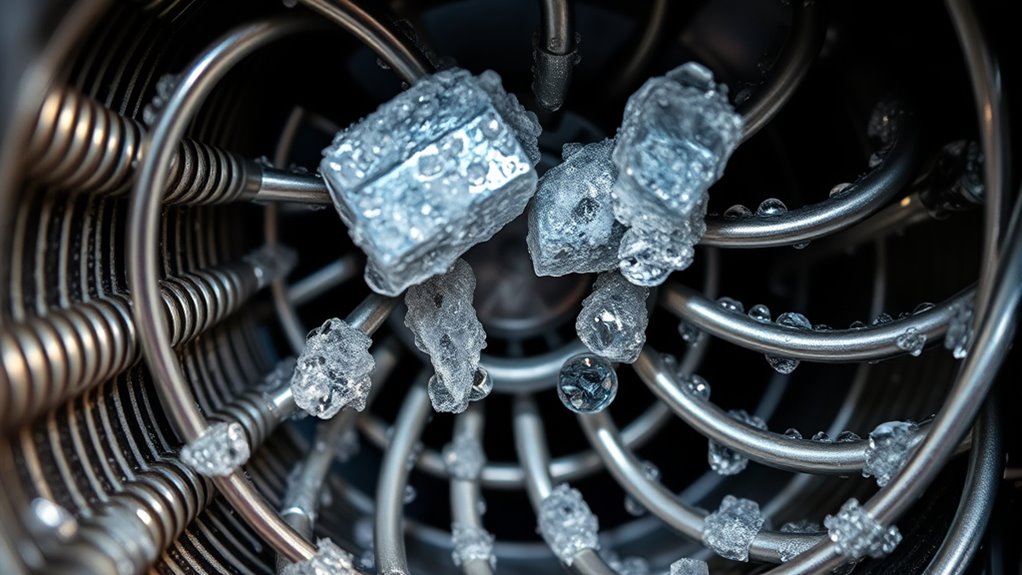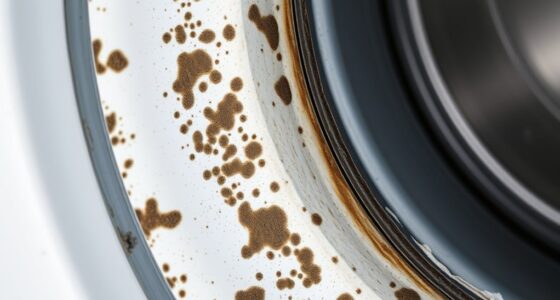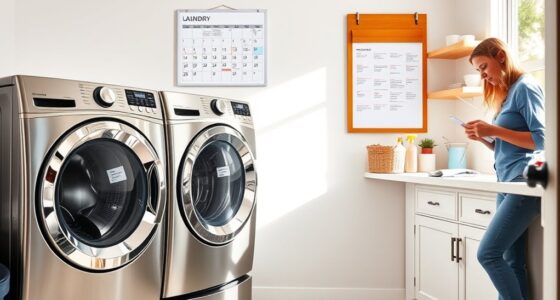To keep your dehumidifier working efficiently, regularly clean the coils by unplugging the unit, removing panels, and gently brushing away dirt and debris with soft tools. Use appropriate coil cleaners or vinegar solutions to remove grime and prevent frost buildup. Check for ice on the coils, especially in cold weather, and defrost as needed. Maintaining cleanliness and managing frost will extend your unit’s lifespan, and more tips await if you continue exploring.
Key Takeaways
- Unplug the dehumidifier and remove access panels to expose the coils safely.
- Gently brush off dirt and debris from coils using soft brushes or coil combs to prevent damage.
- Apply appropriate coil cleaner or vinegar-water solution, then rinse with water or compressed air.
- Dry coils thoroughly, check for bent fins, and straighten fins carefully with a fin comb if needed.
- Regularly perform these steps monthly to maintain efficiency and prevent frost buildup.
The Significance of Regular Coil Maintenance
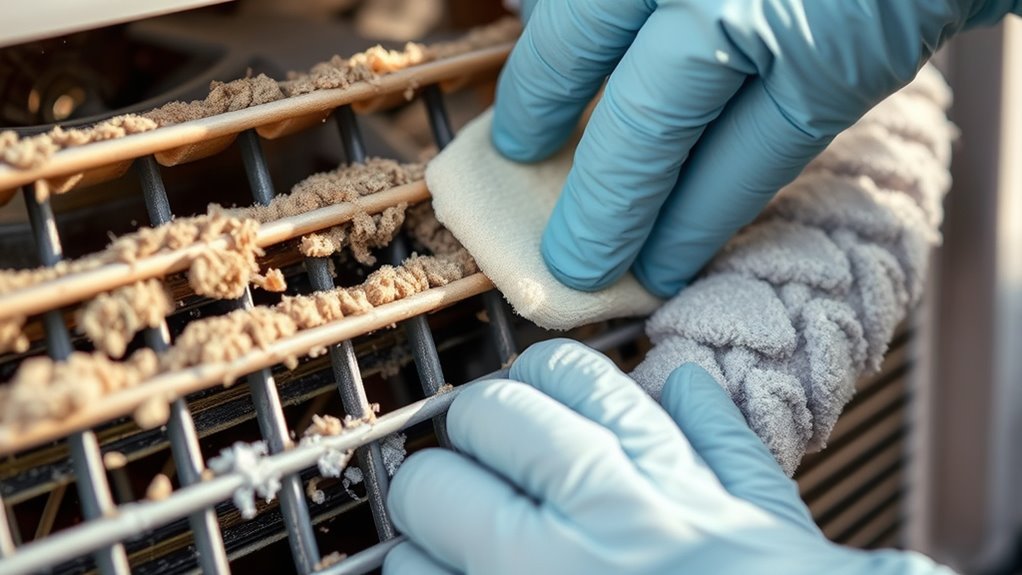
Regular coil maintenance is essential for ensuring your dehumidifier operates efficiently and reliably. When dirt and dust settle on coils, they block airflow, which reduces the heat exchanger’s effectiveness. Even a tiny layer of dirt, just 0.25 mm thick, can cause up to a 20% drop in efficiency. This forces your fan and compressor to work harder, increasing energy use by as much as 30%. Dirty coils can also lead to water leaks, component damage, and higher repair costs, especially if they cause compressor failure. Keeping coils clean helps prevent breakdowns and extends your system’s lifespan. Plus, well-maintained coils improve indoor air quality by reducing humidity, mold, and allergens, making your environment healthier and more comfortable. Routine coil cleaning is a simple yet crucial step that can significantly extend the life of your dehumidifier and enhance its overall performance. Regular maintenance also reduces the risk of system failures caused by dirt buildup, which can be linked to component damage and increased wear and tear.
Step-by-Step Guide to Cleaning Your Dehumidifier Coils
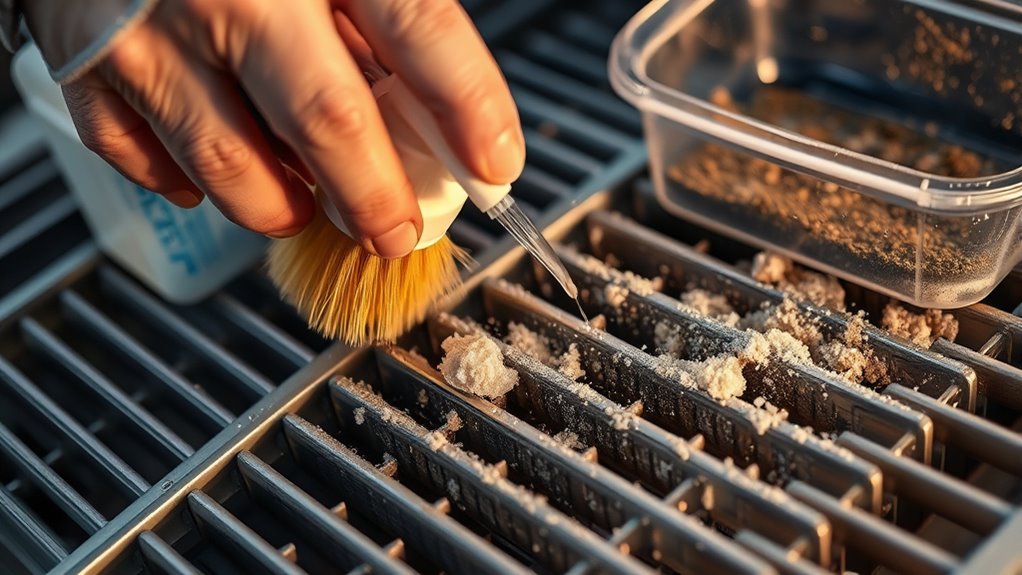
Before you start cleaning, make sure the dehumidifier is unplugged and the workspace is clear to stay safe. Carefully remove the panels to access the coils, and inspect them for dirt or bent fins. Then, follow proper cleaning steps, ensuring all parts are dry before reassembling for peak performance. Regular maintenance helps prevent mold and mildew buildup on the coils, which can impair efficiency and air quality. Additionally, maintaining proper coil cleanliness can extend the lifespan of your dehumidifier and ensure optimal functionality. Keeping the coils clean also supports energy efficiency, reducing overall operating costs and prolonging the device’s life.
Safety and Preparation
Wear gloves to protect against dust and debris, and use eye protection when spraying cleaning solutions. Confirm your workspace is well-ventilated to avoid fumes. Handle coils gently to prevent injury from sharp edges. Additionally, ensure you are familiar with safety precautions to minimize risks during maintenance. Being aware of headphone jack types can also help prevent damage when disconnecting devices.
Cleaning and Inspection
Have you ever wondered how to effectively clean your dehumidifier’s coils to maintain ideal performance? First, turn off and unplug the unit for safety. Remove the front or back panel as per your model’s instructions to access the coils. Gently brush away dust and debris with a soft brush or small broom, taking care not to bend the fins. Apply a coil cleaner following the product’s directions, then spray with soapy water or mild detergent to loosen grime. Rinse with compressed air or water, ensuring thorough but gentle cleaning. Make sure the coils are completely dry before reassembling. During inspection, check for bent fins and straighten them carefully. Also, examine other components like filters and water tanks, cleaning them as needed to keep your dehumidifier running efficiently. Proper coil maintenance techniques can help ensure clear and active communication throughout your maintenance instructions.
Essential Tools and Materials for Effective Coil Care
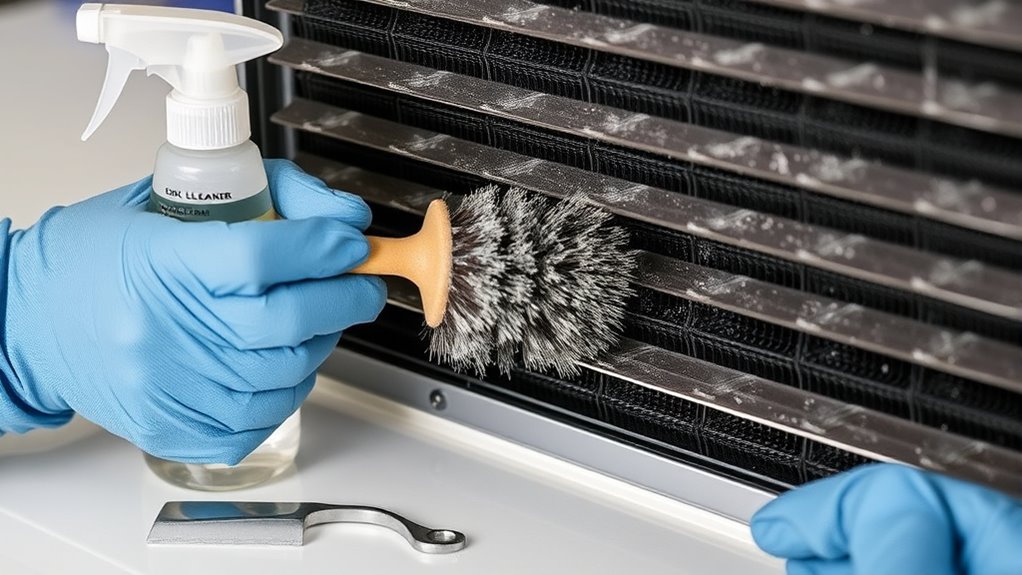
To keep your coils clean and functioning properly, you’ll need specific tools like soft-bristle brushes, coil combs, and spray nozzles. Selecting the right cleaning solutions, such as foam or spray coil cleaners, is essential to remove dirt without damaging the fins or materials. Having these tools and materials on hand guarantees you can perform effective and safe coil maintenance. Additionally, understanding the importance of vetted cleaning products helps ensure your coil care is both safe and effective.
Tools for Coil Cleaning
Cleaning coils effectively requires the right set of tools and materials to guarantee thoroughness without causing damage. Soft-bristle brushes are essential for gently removing dust and debris while avoiding harm to delicate coil fins. Specialized coil cleaning brushes, designed for HVAC and refrigeration units, help reach tight spaces and bendable fins. Anti-static brushes reduce dust attraction during cleaning, making the process more efficient. Coil cleaning combs are useful for realigning bent fins and maintaining airflow. Vacuum attachments tailored for coils efficiently remove debris from crevices. Soft microfiber cloths or wipes gently dry and remove surface dust. Spray nozzles ensure even distribution of cleaning agents, while screwdrivers and panel tools provide safe access to internal coils. These tools ensure safe, effective coil maintenance. Additionally, using appropriate cleaning solutions can enhance the cleaning process and prevent corrosion or buildup.
Cleaning Solutions and Agents
Using the right cleaning solutions and agents can make coil maintenance safer and more effective. Acid and alkaline cleaners remove dirt through chemical reactions but can cause metal loss and pose safety risks. Foaming cleaners help lift debris for easier rinsing, but thorough rinsing remains essential. Non-acidic options like Goodway’s CoilShine are safer and environmentally friendly. Vinegar-water solutions are a simple, natural choice for regular cleaning, disinfecting coils without harsh chemicals. Specialized evaporator coil cleaners, such as Nu-Calgon, simplify maintenance with self-rinsing formulas. Mold and microbial agents like hydrogen peroxide help prevent mold growth, while warm water and detergent soaking loosen grime. Using appropriate cleaning agents can also extend the lifespan of your coils and improve overall efficiency. Regular maintenance with these solutions can prevent coils from losing efficiency and ensure optimal performance. Use this table as a quick reference:
| Solution Type | Key Benefit |
|---|---|
| Acid/Alkaline Cleaners | Strong dirt removal, risk of corrosion |
| Vinegar-Based Solutions | Natural, safe, disinfects, prevents mold |
| Specialized Coil Cleaners | Easy, effective, minimizes coil damage |
| Mold Removal Agents | Prevent mold, improve air quality |
Understanding and Managing Frost Buildup
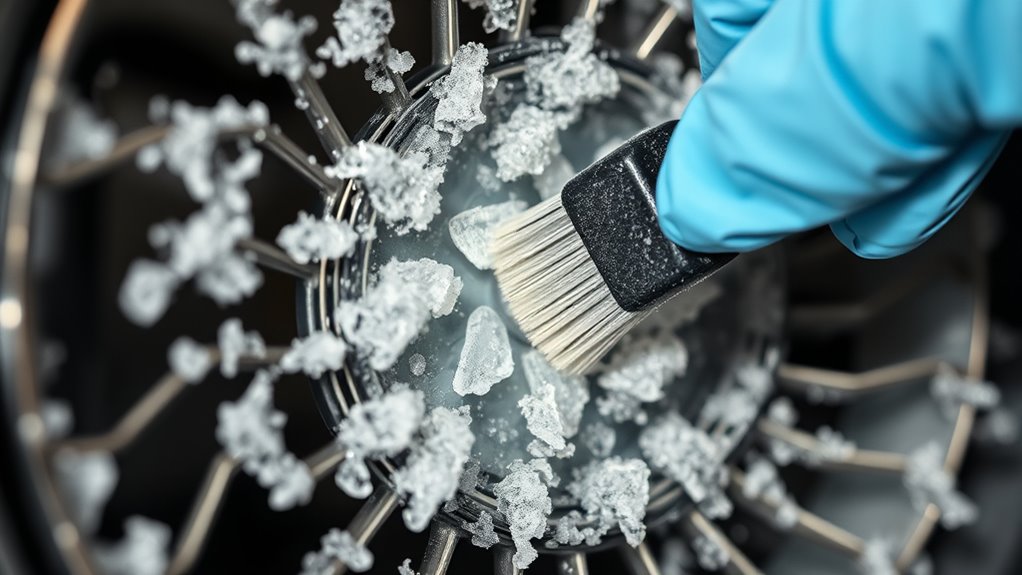
Frost buildup on dehumidifier coils occurs when cold air causes moisture to freeze instead of draining away, often due to low room temperatures or poor airflow. To manage this, you need to recognize the causes and signs of frost.
Here are key points to take into account:
- Maintain room temperature above 60-65°F to prevent freezing.
- Ensure airflow by cleaning or replacing filters and checking vents.
- Regularly service coils to remove dirt and debris that trap moisture.
- Position your unit away from drafts, windows, or cold spots.
- Utilizing AI-driven data analytics can help monitor environmental conditions and predict when frost buildup might occur, allowing for proactive maintenance.
Early detection helps prevent damage. Look for visible frost, reduced water collection, or unusual noises. Proper management keeps your dehumidifier running efficiently and extends its lifespan.
Scheduling Routine Maintenance for Optimal Performance
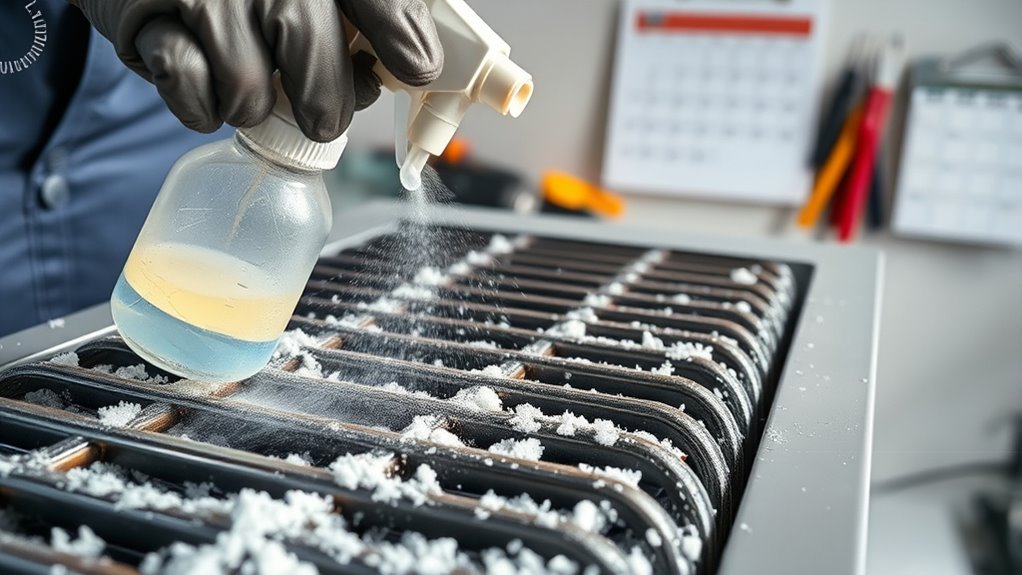
Maintaining your dehumidifier’s performance relies on establishing a consistent routine for regular upkeep. You should empty the water tank daily to prevent overflow and keep moisture removal efficient, especially in high-humidity areas. Monitor indoor humidity levels daily, aiming for 30-50%, to prevent mold growth and ensure comfort. Check the power cord for wear or damage each day to avoid safety hazards. Ensure proper placement with adequate clearance from walls and furniture to maintain airflow, which boosts efficiency. Listen for unusual noises that could signal mechanical issues needing prompt attention. Incorporate monthly tasks like cleaning or replacing filters, inspecting coils, and draining or sanitizing the water reservoir. Regularly performing these routines helps your dehumidifier operate at peak performance and extends its lifespan. Additionally, understanding the weight of your dehumidifier can aid in safe handling and placement. To further optimize its operation, familiarize yourself with coil cleaning and defrost procedures to prevent buildup and ice formation.
Additional Tips to Extend Your Dehumidifier’s Lifespan
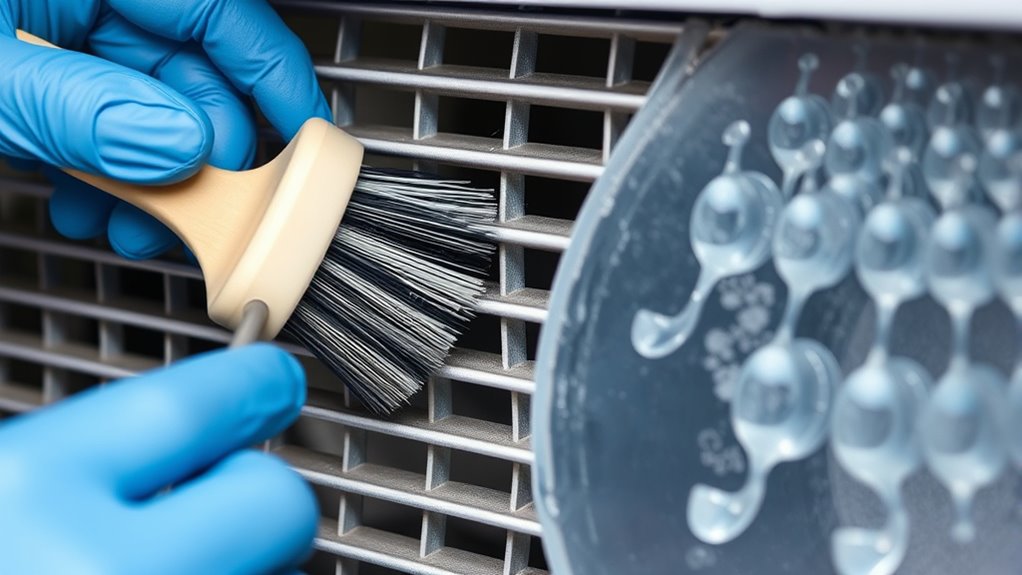
Regularly maintaining your dehumidifier’s air filters is essential for extending its lifespan. Clean filters prevent dust buildup that can clog the system, improve efficiency, and reduce overheating risk. Depending on usage, wash filters every 2 weeks to a month with warm, soapy water, then dry thoroughly before reinserting. Some filters may need replacement, so always follow the manufacturer’s guidance. Incorporating dog names inspiration can also help you remember to check your filters regularly. Additionally, understanding industry transformations such as AI automation can inform proactive maintenance approaches that future-proof your equipment.
Regularly clean or replace dehumidifier filters to ensure optimal performance and longevity.
To further prolong your unit’s life:
- Empty and clean the water tank daily and weekly with mild detergent to prevent mold.
- Inspect and clean coils every few months to maintain peak moisture removal.
- Place the dehumidifier in a well-ventilated, dust-free environment, away from heat sources.
- Use a hygrometer to monitor humidity, avoiding overuse and reducing system strain.
Frequently Asked Questions
Can I Clean the Coils Without Unplugging the Dehumidifier?
You shouldn’t clean the coils without unplugging your dehumidifier. Doing so risks electric shock, short circuits, or damaging internal components. Always turn off and unplug the device before cleaning. This guarantees safety and prevents water or cleaning solutions from contacting electrical parts. Taking this precaution protects you and prolongs your dehumidifier’s lifespan, making the cleaning process safer and more effective.
How Do I Know if the Coils Need Cleaning?
Imagine your dehumidifier’s coils as the lungs of the system—if they’re clogged, it struggles to breathe. You’ll notice visible dust, debris, or frost buildup, and the unit takes longer to reduce humidity or uses more energy. Unusual noises and reduced efficiency are signs too. When you see these signs, it’s time to clean the coils to restore proper airflow and keep your dehumidifier working smoothly.
Is It Safe to Use Vinegar on Dehumidifier Coils?
Yes, it’s safe to use vinegar on dehumidifier coils if you do it carefully. Mix equal parts water and vinegar, then lightly spray or soak removable parts. Use a soft brush or cloth to gently clean, avoiding harsh scrubbing. Rinse thoroughly with water afterward, and make sure the coils dry completely before reassembling or turning the unit back on. Always unplug the device before cleaning.
How Often Should I Replace the Dehumidifier’s Filters?
Replacing your dehumidifier’s filters is like changing the oil in a car—vital for smooth operation. You should generally replace disposable filters every 3 months and clean reusable ones regularly. For whole-home units, aim for annual replacements. If your environment is dusty or polluted, check filters monthly and replace or clean more often. Always follow the manufacturer’s guidelines and inspect your filters often to keep your dehumidifier working efficiently.
What Are Signs of Frost Damage on Coils?
You’ll notice frost damage on your coils if you see visible ice or frost buildup directly on them, or if water droplets freeze around the coils instead of dripping down. If the coils are partially or fully covered with ice, or if they feel unusually cold and frosty to the touch, that’s a clear sign. Also, restricted airflow, poor performance, and frequent shut-offs often point to frost damage on your coils.
Conclusion
Regular coil cleaning and defrosting can boost your dehumidifier’s efficiency by up to 20%. Did you know that neglecting maintenance can cause your unit to use 30% more energy? By staying on top of coil care, you not only save money but also extend your dehumidifier’s lifespan. Make maintenance a routine—your equipment will thank you, and you’ll enjoy fresher, healthier air every day.
